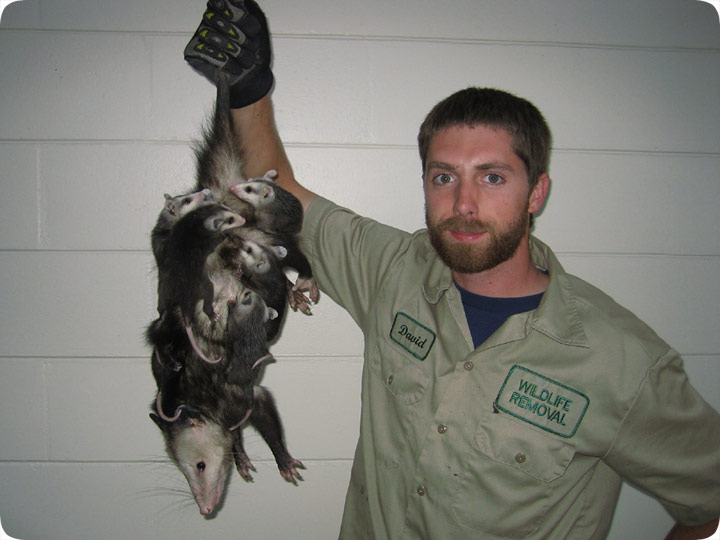-
info@aaanimalcontrol.com
Call us for help in your town
Humane Wildlife Education
Female Opossum With Babies on Her Back

04.16.2006 - This is one of the things that opossums are well-known for. A group of baby opossums clinging to the back of the mother opossum. This kind of thing is common at this time of year, mid-April, because the female possums have their young in the late winter and early
spring, and by this point, the young are grown to a size large enough to spend most of their time outside of the pouch and clinging directly to the back of their mother. It's actually an interesting game of survival. The female opossum has 13 nipples. So at the very beginning, there's
competition to get a nipple. Babies are born, usually more than 13 of them, at a very tiny size, like a kidney bean. They find a nipple and stay put, but those that don't find a nipple die. Then they grow, and they crowd each other. There's less and less space to hang on as the young
grow larger, so some of them get shoved off, and have to fend for themselves. Many of these little possums are very small and not yet ready, and they will likely not survive, as they fall prey to predators.
In this photo, there's eight young (though you can't see them all from this angle). It's very crowded on this mama possum's back! Soon more and more young will
drop off, until there's only three or four left in mid August, and then it's time for these last few to leave their mom. The ones that have stayed on for the longest
amount of time and grown the largest stand the best chance of survival.
The opossum, (Didelphis virginiana) is a nocturnal animal that lives in North America. It is a marsupial, which means that the females give birth to tiny young, who grow in a pouch. These young eventually cling to the mother's back and drop off when they are large enough.
Opossums are unique for many reasons. They have opposable thumbs, prehensile tails, 50 teeth, and several other unusual features. They are omnivores who eat almost anything, they have excellent immune systems, and they rarely live more than 2-3 years in the wild. They are most
commonly considered a nuisance species when they live in an attic or other structure, such as under a shed, or steal pet food or threaten animals.
Do it yourself: Visit my How To Get Rid of Opossums page for tips and advice.
Get professional help: Visit my Nationwide Pro Directory of wildlife removal experts.
For more wildlife stories, click my Wildlife Blog
or click my below banner to hire a local trapper.
Opossums are one of those animals that are considered dumb by the majority of people. A lot of the human population thinks of them as brainless and not smart enough to survive difficult situations. However, this is not entirely true. Opossums have more to offer and opposed to the common belief, they are quite the creatures. They are very interesting animals and if you look into them you can find many things that will catch your interest. One such aspect of their life that researchers spend a lot of time looking into is their mating and reproduction behavior. There are many things regarding this which you might not know.
Like any other animal, they have their mating months which are from October to December and a majority of the births take place between February and June. The female opossum gets attracted to a male opossum through the special clicking sounds it makes. A female can give birth to a maximum of 20 babies at one time in one litter (average is 8-9 infants) and throughout the year can produce up to 3 litters of babies. A female will only gestate for 11-13 days before giving birth. This short gestation period allows it to give multiple births within a year.
At the time of birth, these opossums are very small weighing an average of 0.13 grams and all of them can fit in your palm; they are also hairless and pale. At the time of birth, the infant is required to leave the birth canal and find its way into the pouch. There are 13 nipples present and it should latch onto one to survive. If they don't find a nipple, their survival becomes very difficult.
As time passes and they start to grow, the space in the pouch becomes tighter and they eventually crowd each other. Some get pushed by the other infants and eventually die due to hunger or fall prey to other animals. Gradually, one by one these infants start falling from the pouch; at the end, only 2-4 survive. These babies then move on to cling to their mother's back. The reason for this is that the pouch becomes too small to fit them all so they are carried by the mother on her back. The babies then assist and watch their mother as she goes out and finds food for herself. During this time, they take notice of all the skills they might need to survive and equip themselves to not fall prey to an animal. Sometimes a baby can fall off the mother's back and get lost, in that case, it sneezes or makes similar sounds to call out to its mother. The mother responds by making sounds similar to that of clicking. After being weaned at 3 months, the babies start to become independent and part ways with their mother.




















